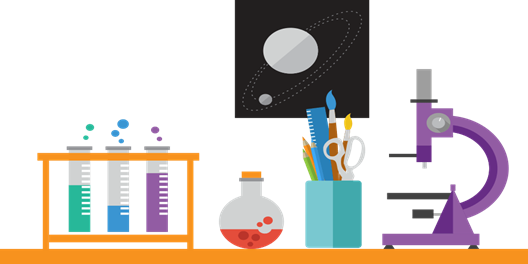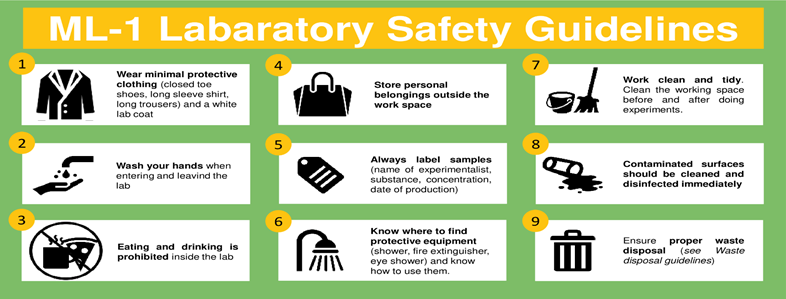SCIENTIFIC EXPERIMENTATION, LAB
SAFETY, AND SCIENTIFIC INVESTIGATION

Data is collected in science by performing experiments.
Properly conducted experiments are usually organized into six
steps: Experiments are part of the scientific method. Let's go over
the six steps of the experimental stage.
|
SIX STEPS OF THE EXPERIMENTAL STAGE |
|
1. Gather materials |
|
2. Know how to use a piece of
equipment |
|
3. Observe and record data |
|
4. Identify a single test
variable and control other variables |
|
5. Perform measurements |
|
6. Use mathematics |
Lab Safety: Everyone is Responsible!

When preparing to experiment, safety first. The appropriate
lab clothing must be worn, including an apron, safety glasses, fume hood, and
gloves. The conducted experiment determines the amount and kind of safety
equipment used. If chemicals are being used, one will refer to the MSDS
(material safety data sheet), which will list safety precautions to be followed
when working with the chemicals and a medical response if a spill or accident
occurs.
The purpose of the video on awareness of safety in the
science laboratory is to raise students' consciousness regarding the need to
follow directions and observe precautions in the laboratory. Awareness of
laboratory safety considerations and the following safety procedures should be
constant.
1. Students must learn to follow the instructions of either
the teacher or the textbook. The most important rule is to follow
the teacher's instructions or the directions in the book precisely.
2. Students must learn the meanings of symbols or icons
associated with hazards
and what precautions to take when warned of a hazard.
3. Prevention of accidents should be stressed to protect each
student and others in the environment.
Click here to watch the video.
(username: jcesc password: qfaf9361)
Scientific Experiment
A scientific experiment is conducted to answer a
question. When attempting to answer that question, the scientist
must be in control of all things happening in the experiment to allow
him the opportunity to determine the exact cause or reasons for the result. An
essential part of an experiment is the control items since the controls set
the standard for comparison in place. It is necessary to have control
to determine the variable's results that are being tested in the experiment.
Example: A scientist wants to determine, "How
does sunlight affect plant growth?" (Problem–question) Then
the scientist predicts the experiment's outcome, "more sunlight will cause
more plant growth" (hypothesis). The scientist could put
ten plants in the sun for 6 hours a day and ten plants in the sun for 10 hours
a day (Procedure). This is the only difference between the two
groups of plants (variable). All other parts, materials, and procedures
must be the same (control). If the scientist were also to
give the plants different amounts of water or plant them in different soil, it
would be impossible to determine which factor affected the plant growth.
For this reason, you can have only one factor that varies in
a scientific experiment. The experiment is ready when the materials,
equipment, and measuring devices are prepared (procedure). As the
scientist experiments, measurements are recorded, observations are recorded,
controls are maintained, and only the variable changes (test). When
the testing is completed, the measurements and observations are calculated, and
a conclusion is drawn.
Scientific experiments and observations are often used to
create laws and theories. Although these two concepts are often used
interchangeably, they mean two different things. A scientific law describes
the behavior of matter and energy and is sometimes thought of as a rule of
nature. Example: A person sitting at the beach for an extended
period describes to a friend that the water rises and falls, causing a high
tide and a low tide. That person describes an event in nature, but
there is no attempt to explain why the water changes levels. A
Theory is an explanation based on observations and experiments. The theory that
explains high and low tides is that the moon's gravity is responsible for high
and low tides.
Once again, one needs to realize that nothing is certain in
science. Laws and theories may have been thought to be true for hundreds of
years and supported by thousands of scientists. It is always possible that a
new experiment may produce evidence or results which disagree with the law. If
the new experiment is correct, the old law may be rewritten to support the new
data, and the old law may be discarded as no longer accurate. Most laws are not
entirely discarded but are rewritten. Science tends to become more exact as our
technology improves, and experiments can be conducted using improved
techniques.